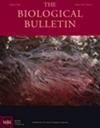海星种群的人口学、生态学和管理:《生物学通报》特刊导论。
IF 1.9
4区 生物学
Q2 BIOLOGY
引用次数: 1
摘要
本文章由计算机程序翻译,如有差异,请以英文原文为准。
Demography, Ecology, and Management of Sea Star Populations: Introduction to a Special Issue in The Biological Bulletin.
Sea stars (Echinodermata: Asteroidea) are one of the most recognizable and iconic organisms in the marine environment. With nearly 1900 extant species from 370 genera, grouped into 36 families, sea stars are considered one of the most diverse groups of extant echinoderms (Mah and Blake, 2012. PLoS One 7: e35644; O’Hara and Byrne, 2017. Echinoderms: Biology, Ecology and Evolution). This special issue focuses on ecologically important keystone species, including the crown-of-thorns sea star (Acanthaster sp.), which is present in tropical and subtropical waters; the temperate species the northern Pacific sea star (Asterias amurensis), the ochre sea star (Pisaster ochraceus), and the sunflower sea star (Pycnopodia helianthoides) from the north Pacific; and the spiny sea star (Marthasterias glacialis) from the north Atlantic. Seminal work by Professor Robert Paine demonstrated that the removal of a top predator, Pisaster ochraceus, can alter the diversity, abundance, and distribution of other organisms within an ecosystem—giving rise to the concept of “keystone species” (Paine, 1966. Am. Nat. 100: 65–75). Subsequent studies have further revealed the role of sea stars as important predators in intertidal and subtidal ecosystems, as well as the influence of demographic and environmental factors on predator-prey interactions (reviewed by Menge and Sanford, 2013. Ecological role of sea stars from populations to meta-ecosystems. Pp. 67–80 in Starfish: Biology and Ecology of the Asteroidea). The ecological and economic ramifications of irruptions of, or the collapse of, sea star populations have been well documented. For example, outbreaks of the corallivore Acanthaster sp. have led to widespread mortality of reef corals in the Indo-Pacific (Chesher, 1969. Science 165: 280–283; De’ath
求助全文
通过发布文献求助,成功后即可免费获取论文全文。
去求助
来源期刊

Biological Bulletin
生物-海洋与淡水生物学
CiteScore
3.30
自引率
6.20%
发文量
47
审稿时长
6-12 weeks
期刊介绍:
The Biological Bulletin disseminates novel scientific results in broadly related fields of biology in keeping with more than 100 years of a tradition of excellence. The Bulletin publishes outstanding original research with an overarching goal of explaining how organisms develop, function, and evolve in their natural environments. To that end, the journal publishes papers in the fields of Neurobiology and Behavior, Physiology and Biomechanics, Ecology and Evolution, Development and Reproduction, Cell Biology, Symbiosis and Systematics. The Bulletin emphasizes basic research on marine model systems but includes articles of an interdisciplinary nature when appropriate.
 求助内容:
求助内容: 应助结果提醒方式:
应助结果提醒方式:


